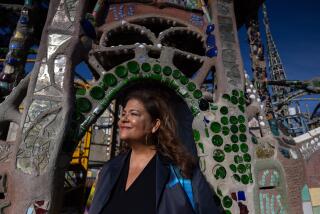Stump Is Reminder of Hermit Who Perched on Pillar for 42 Years
- Share via
QALAAT SEMAAN, Syria — Simeon the Elder, legend has it, went to the mountaintop to be nearer his God. The mountain wasn’t high enough, so he erected a pillar.
He stood on it. Sat on it. Lived on it.
For 42 years.
He raised several pillars, in fact, each higher than the one before. For almost two-thirds of his life, he followed his quest to avoid earthly sin by staying above it. The pillars that held him aloft were as short as 3 feet, as tall as 50 feet.
St. Simeon Stylites, the world’s first pillar hermit, died in AD 459 at age 69. Today the stump of his column on a mountaintop near the Turkish border is one of Syria’s best-known tourist attractions.
“To understand such a person as Simeon, you have to understand the times,” said Peter Grossmann, an expert on early Christian archeology. “They were crazy.”
Grossmann, of the German Archeological Institute in Cairo, Egypt, spent some time living with Syrian farmers and studying abundant Roman and Christian relics in nearby valleys and hills.
He said the key to understanding Simeon and others like him is that they came along as the persecution of Christians was ending. Thus, they had to find ways other than Roman torment to prove their faith and to spread it.
“You had people like Simeon who wanted to show their faith in very intense, outlandish ways,” Grossmann said. “He dictated letters to others, shouting at them for not being strong enough. Simple people were being pushed into outrageous deeds, and Christian priests showed a total lack of feeling for the consequences.”
Roman coins had the emperor’s picture on them. Early Christians wouldn’t use them because they considered the imagery sacrilege. Early Christian soldiers put themselves in deep trouble with their superiors when they refused on religious grounds to celebrate victories by wearing the Roman army’s traditional crown of victory.
“This was the atmosphere that created a man like Simeon,” Grossmann said.
Simeon’s excesses so angered fellow monks that to escape their faultfinding, he fled to his mountaintop wilderness 60 miles northwest of Aleppo.
Even today, it is an isolated place. Most visitors arrive by bus over a modern road winding upward from farmland through a savage and barren no-man’s land to the summit of Mt. Simeon.
On a recent day, under a warm sun, generations of Syrians picnicked on olives, bread and cheese spread on carpets of wildflowers in the ruins called by the Arabs Qalaat Semaan: Simeon’s Fortress. They ate looking at a panorama of majestic plains and valleys, its dead cities and long-silent monasteries silhouetted through Roman arches towering above the stub of Simeon’s column.
Lingering groups of French and American tourists meandered among ruins of a four-winged basilica, hostels, a baptistery, a monastery and chapels. Most paused in the basilica’s courtyard to be photographed beside the pillar.
“This was a man who knew how to give himself a fantastic view,” said one tourist, John Rodenbeck, a classics professor from American University in Cairo. “The buildings are wonderful. They reek of holiness.”
Ancient pilgrims came on foot to the column via a ceremonial pathway. They passed beneath a triumphal arch still partially standing in Telanissos, a village at the bottom of Mt. Simeon.
Many were peasants and nomads who roamed the plains. Others came from Armenia, Persia and beyond.
St. Simeon prayed and preached from his high perch. Visitors sought his advice on curing illness or solving problems. Some came simply for spiritual renewal.
The pilgrims brought Simeon meager gifts of food, which disciples took to him by ladder or he came down to get.
There are varied descriptions of how he lived his life of self-denial. Some accounts say he spent most of his years chained at the top of his perch. Some say he descended the ladder for brief periods twice daily. Most chroniclers agree that he had only a handrail to hold on to, but some say he could sit, in a niche at the top.
There’s argument even on how long he stayed: 35 years, 37, 39 or 42. Syrian guides and many scholars insist on 42.
A 6th-Century gold panel in Paris’ Louvre depicts St. Simeon bearded, sitting on his column backed by a symbolic seashell. A serpent-like creature coils around the pillar.
It’s also not certain at what point in Simeon’s life he mounted his first pillar.
“He had tried to prove his faith in other ways before he decided to mount his column,” Grossmann said. “One was to dig a hole and stay in it. Of course, you could dig deeper and deeper, which he did, until only his head showed. But there comes a time if you want to stay alive you can’t go deeper, so he had to think of something else.”
That, Grossmann said, is when Simeon decided “to go the other way. Up.”
The 3-foot pillar proved unsatisfactory because of the human contact it allowed when people came to see the Simeon oddity. But Grossmann said the hermit soon found that getting away from them forced him to give up a bit of his solitude in another way.
“He had to make a taller column, but he couldn’t do it alone,” Grossmann said. “He was forced to accept followers.”
More to Read
Sign up for Essential California
The most important California stories and recommendations in your inbox every morning.
You may occasionally receive promotional content from the Los Angeles Times.










